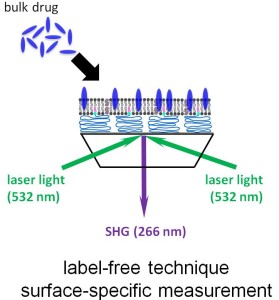Second harmonic generation (SHG) is a nonlinear optical tool that students in the Stokes Lab use to directly measure adsorption of organic molecules to biologically-relevant (insulating) liquid/solid interfaces. In our lab, we employ two beams of 532 nm high-intensity laser light from a 10 Hz nanosecond Nd:YAG laser. Second harmonic light (with frequency 266 nm) is generated with these two beams are overlapped (in space and time) at an interface. The molecules we study generally exhibit inherent absorbance of light ~266 nm, which results in a resonance enhancement of the SHG signal. We are able to detect organic molecules on surfaces at sub-monolayer surface coverage. SHG signal is not generated in bulk media because dipoles are isotropically distributed, but is only observed at an interface, where symmetry is broken. The intensity of the SHG light we detect can be used to determine the relative concentrations of organic molecules adsorbed at the liquid/solid interface at varying aqueous concentrations to provide an adsorption isotherm. As SHG is a coherent spectroscopy method, we can choose polarization combinations of the input and SHG light fields to determine the relative orientation of adsorbed molecules at varying aqueous concentrations.
Here are some photos from our laser lab:


Recent Comments